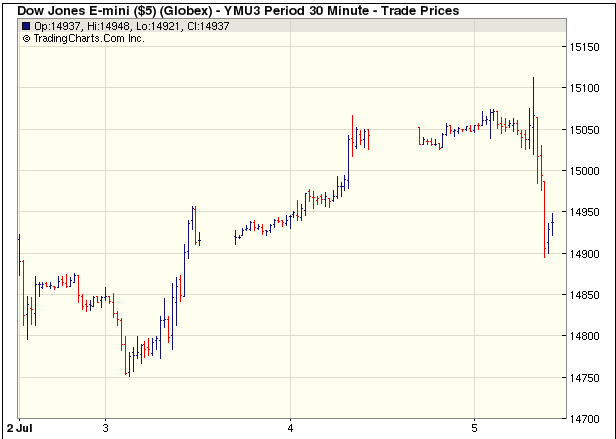Bonds & Interest Rates
We have clearly been in a recent run of higher interest rates, with a looming “threat” that there might be less quantitative easing before the end of the year. It would appear now that Bernanke wants to leave his successor to implement what everyone knows must be coming at some point: a return to a normal interest-rate environment. While rising interest rates are bad for me personally (for another four months), a return to normalcy would be good for our future – though the transition is likely to be bumpy.
With this in mind, I offer this week’s Outside the Box from Louis and Charles Gave. In a brief essay entitled “Bad Omens,” they note:
… if the recent global equity market sell-off can be laid at the feet of the 100bp move higher in US bond yields, it is hard to know how another 50bp increase in real rates will be digested.
US investors might not have noticed, but there is carnage scattered here and there on the world’s markets, and not just the equity markets. The central banks of the world, in their furious attempts to promote stability through easy-money policies, have cooked up a witches’ brew of instability of unknown quantity and contents. There is no set formula for this concoction; they are making it up as they go along. Anything that seems to calm the storm momentarily becomes the order of the day. Bernanke hints at the mere possibility of less easing (not tightening, God forbid!), something that we all know must happen at some point, and the market throws up and half a dozen Fed governors go on the air to say “Not really … maybe … we are going to be cautious … we’ll go slow … no one wants to do anything rash” – etc. It was almost comical.
Thus we can expect a volatile summer (as the interns man the trading desks), and I think you will find the Gaves’ insights useful. – John Mauldin, Editor Outside the Box JohnMauldin@2000wave.com
Ed Note: Be sure to read the conclusion in the article “Bad Omens”
Bad Omens
By Louis Gave & Charles Gave
In late May we published a debate piece on the near-term outlook for equity markets. Since then, emerging markets have once again lived up to their name by proving themselves hard to emerge from during an emergency (in USD terms, Brazil is down –35% year to date while Chinese valuations are back to 2008-crisis levels); for their part, European and US equity markets have pulled back, while the only salvation has come from Japan (the one market where it’s possible to find attractive valuations, accelerating economic activity and liquidity growth feeding off a Tour de France vitamin cocktail). But is this a case of Japan being the best looking horse in the glue factory? In the following paper, we aim to review a number of signs from equity markets that look somewhat ominous. Needless to say, we welcome any feedback on the below.
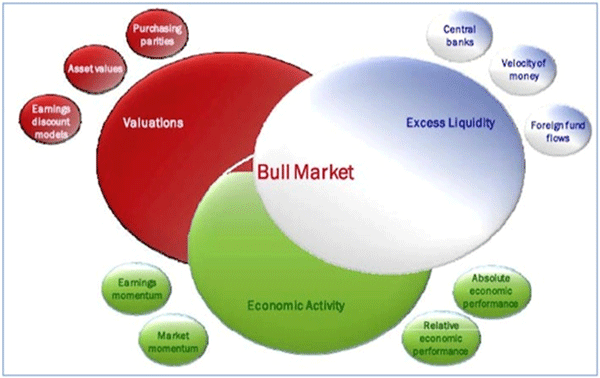
The question at hand: is this a break-out?
The chart over-leaf traces the relative performance of the S&P 500 against long-dated bonds since the Asian Crisis in 1997. Since then, the world has experienced a series of deflationary shocks, each of which has been met by more activism from the Fed and other central banks: i.e.: lower rates and higher monetary base growth. And each time, the excess money allowed for the rise in a few asset classes (TMT in the late 1990s, housing and financial intermediaries in the mid 2000s, commodities, fixed income instruments and emerging markets in the late 2000s…). But each time, the asset price rise was followed by an equity market bust; begging the question of whether the bust that seems to be unfolding in emerging markets is now the third iteration of a movie every investor has seen before (and which few have enjoyed)? Or whether the recent correlation between bonds and equities indicates that the repeated deflationary shocks are a thing of the past and nominal GDP g rowth will accelerate from now on? Could we be at a structural turning point?
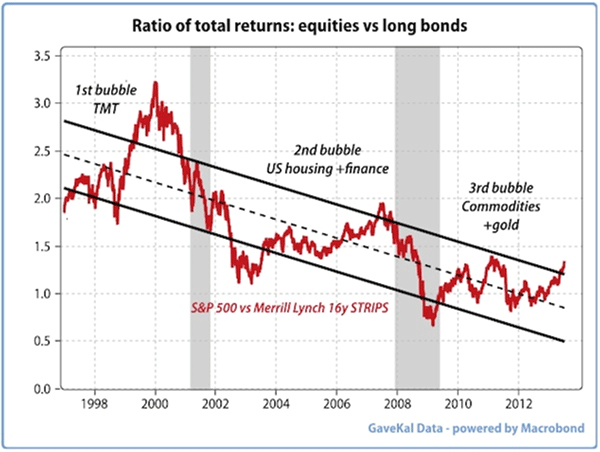
1– A first bad omen: fewer markets rising
In the chart below, we take the top twenty equity markets in the world and compile a diffusion index that shows how many rose in the previous six months, against how many fell. So when the grey bar is at +20, global equity investors have made money in every major market; when the index reads –20 they found nowhere to hide. And when the number is in negative territory, it simply means that more markets have fallen then risen in the previous six months. The red line is the performance of the S&P 500. Since 1992, we have had 14 occurrences in which more stock markets were falling than rising. In 10 of these 14 occurrences, the S&P500 fell by at least –10%. In the other 4, the S&P 500’s performance hovered between 0% and –10%. As things stand, the S&P 500 has recorded a double digit rise in the past six months, a major divergence.

2– Another bad omen: collapsing silver prices
Unfortunately, it’s not as if, lately, equity markets have been the only place to lose money. Indeed, as every gold bug has rediscovered in recent months, precious metals have again proven that they are anything but a safe-haven. Still, drops of 30% or more in silver prices do not happen that often: looking back at the past 100 years, such drops have only occurred 11 times. And interestingly, each one of these massive declines marked a significant change in the world financial system.
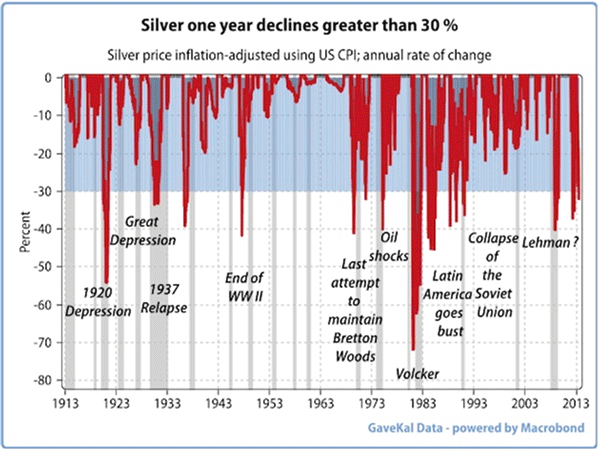
To cut a long story short, the investment rules after large declines in precious metals were almost always totally different from the rules which prevailed before the fall. More worryingly, each such decline was accompanied by a massive recession/depression somewhere in the world and almost every time by a recession in the US (grey shaded areas), the only exception being 1983-1984 when the Latin American depression did not trigger a US recession but instead a collapse in oil prices.
3– Beyond stocks and precious metals
Let us imagine a pension fund whose assets are invested conservatively with 40% in global fixed income, 40% in global equities, 10% in the world’s largest hedge funds (Bridgewater, Man-AHL, AQR…), 5% in gold and 5% in private equity. Leaving aside the private equity illiquid pocket, our pension fund will have basically lost between 5% and 15% of its assets across the board in just a few weeks.
Following these widespread losses, will our pension fund look to a) increase its risk and average down on the more beaten-up asset classes (i.e.: emerging market equities) or b) reduce its risk and use the recent rise in yield to immunize liabilities (or reduce its portfolio’s volatility)? In a world directed by VaR measures, CAPM models, and CYA boards, is that even a question?
4– Falling inflation expectations
Not that the imagined pension fund in question would automatically be wrong in increasing its fixed income allocation. After all, inflation expectations in the US (and almost everywhere) are falling like a stone, implying that fixed income instruments now offer a much higher real yield than the recent rise in nominal interest rates might imply:
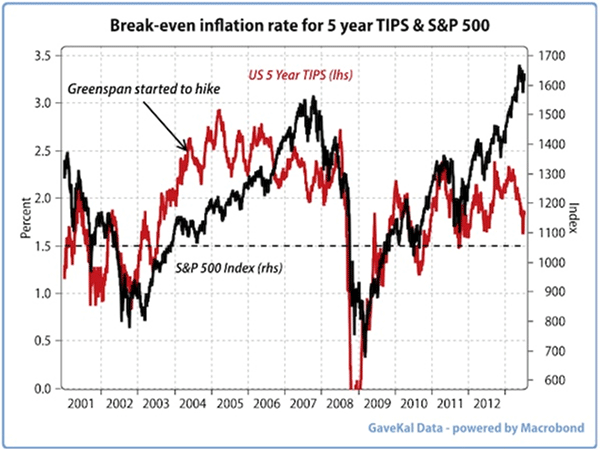
And these collapsing inflation expectations bring us to the chart above for, since the Asian Crisis, each time US inflation expectations fell below 1.5% (i.e.: a deflationary shock), US equities took a beating. That [doted] line in the sand is approaching fast. Just as worryingly, the collapse in inflation expectations, combined with the rise in nominal rates, means that the recent rise in US Baa real bond yields is the biggest one witnessed since the start of 2009—when bond markets were massively overbought.
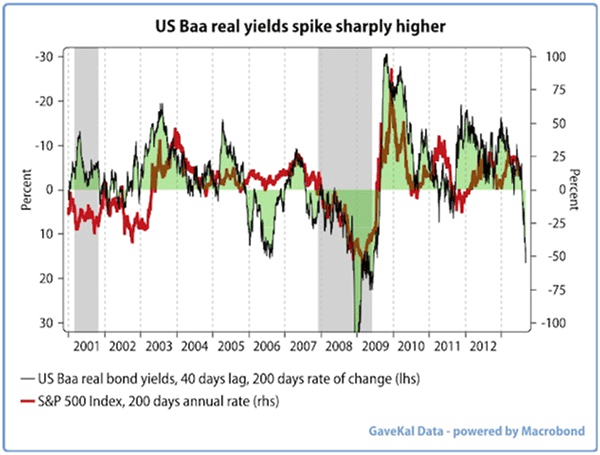
Of course, one could argue that the recent rise in yields is nothing to worry about; that it is just the side effect of the air coming out of the bond market bubble (see our Quarterly Strategy Chart Book 2Q12—The Global Bond Yield Conundrum). Unfortunately, recent weeks have shown that such an attitude may be too carefree as most assets have reacted badly to falling bond prices. Indeed, if the recent global equity market sell-off can be laid at the feet of the 100bp move higher in US bond yields, it is hard to know how another 50bp increase in real rates will be digested? Looking at the bond vs equity trade-off today, it is easy to imagine Woody Allen saying “we have reached a cross-road. One way (rising yields?) leads us to despair and annihilation, the other (falling yields?) to certain death. I hope we choose wisely.”
Conclusion
So here we are, with:
- China, the single biggest contributor to global growth over the past decade, slowing markedly.
- World trade now flirting with recession.
- OECD industrial production in negative territory YoY.
- Southern Europe showing renewed signs of political tensions (i.e.: Portugal, Greece, Italy…) as unemployment continues its relentless march higher and tax receipts continue to collapse.
- Short-term interest rates almost everywhere around the world that are unable to go any lower, even as real rates start to creep higher.
- Valuations on most equity markets that are nowhere near distressed (except perhaps for the BRICS?).
- A World MSCI that has now just dipped below its six month moving average.
- A diffusion index of global equity markets that is flashing dark amber.
- Margins in the US at record highs and likely to come under pressure, if only because of the rising dollar (most of the US margin expansion of the past decade has occurred thanks to foreign earnings—earnings that may now be challenging to sustain in the face of a weaker global trade growth and a stronger dollar).
Lackluster growth? Falling margins (outside of Japan)? Rising real rates? Unappealing valuations (outside of the BRICS)?… Perhaps these make up the wall of worry that global equities will climb successfully. After all, if the British and Irish Lions can win a rugby series in the Southern hemisphere, while a Scotsman wins Wimbledon, then nothing is impossible. Though perhaps the simpler explanation to the above growing list of bad omens was formulated by Claudius who said that “when sorrows come, they come not as single spies, but in battalions”.

To best answer the question as to where U.S. Treasury yields are headed in the next quarter or two, it is important to know where they would be without the manipulation of our central bank, where they would be in a growing economy and, also, absent the threat from an imminent collapse of a major foreign currency.
The current yield on the Ten-Year Note is 2.6%, up from 1.6% less than two months ago. True, that rate has surged of late but it is still far below its 40-year average of around 7%. But just prior to the beginning of the Great Recession (in fall of 2007) the yield on the Ten-Year Note was 4%–140 basis points higher than today.
And in the spring of 2010; a year after the recession ended, the conclusion of QEI and prior to the Greek bailout, the Ten-Year posted a yield of 3.8%. Therefore, it isn’t at all a stretch to anticipate yields going back toward 4% in the very near future–If indeed it is true that we are not currently in a recession, the Fed will soon start to winding down QE and there is no mass piling into Treasuries from a collapsing foreign currency.
What’s more, the Fed now holds over $3.5 trillion worth of securities on its balance sheet, $1.9 trillion of which are U.S. Treasuries. That compares with just $800 billion at the start of 2008. This means if the market now believes the Fed has started down the path of eventually unwinding its balance sheet the selling pressure will be immensely magnified as compared to several years ago. In addition, due to banking distress in China and a back up in yields in Japan, these sovereign governments may not be able to support Treasury prices to the same extent as they did in the past. These two nations already own $2.3 trillion of the current outstanding $11.9 trillion worth of Treasury debt.
Meanwhile, the Fed persists in sophomoric fashion to scold the market for misinterpreting its mixed messages about tapering the amount of asset purchases. But the big surprise for Mr. Bernanke and co. will be the realization that they have much less control of long term rates than they now believe.
I’ve been on record warning that once the market perceives the exit for QE is near, yields will rise. Nevertheless, expect most on Wall Street to claim the increase in rates has its basis in a growing economy and, therefore, represents good news for markets. But the true fallout from interest rate normalization will not be pretty; for it will reveal a banking system and an economy that is perilously close to insolvency.
Michael Pento
President: Pento Portfolio Strategies
O (732) 772-9500
M (732) 213-1295
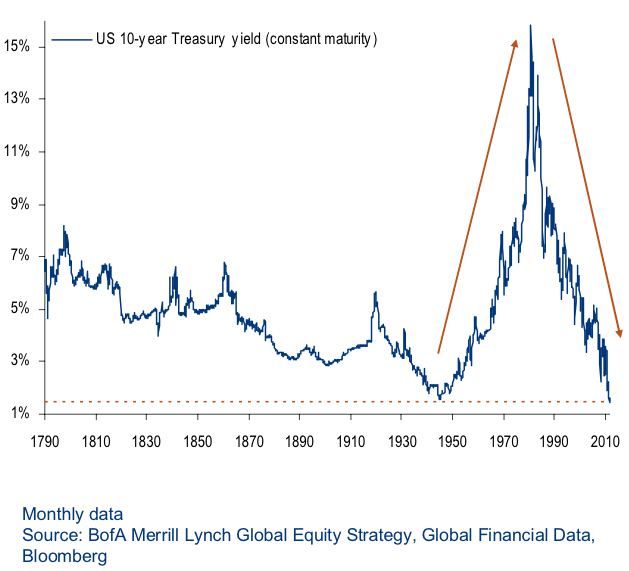

 The Fed’s EZ money policies will either succeed or fail. Either way, it will be a disaster.
The Fed’s EZ money policies will either succeed or fail. Either way, it will be a disaster.
If they succeed, interest rates will rise… and America’s debt-addicted economy will get the shakes.
If they fail, the Fed will double down with further acts of reckless improvisation – including bigger doses of credit – until the whole thing blows up.
On Friday, it looked as though the disaster might come from success. Gold took another solid right to the jaw – down $39 per ounce. The Dow rose another 147 points.
The proximate cause was the latest news from the jobs arena. Apparently, employers are once again reaching out and dragging able-bodied men and women into their shops.
“What does this mean?” investors asked themselves.
“The Fed can now taper,” said some. “Sell gold!”
“The economy is recovering,” said others. “Buy stocks!”
We noticed a few mean-spirited comments on the Internet, sniping at the figures. One website post told us that most of the new jobs are as waiters and bartenders. Another reminded us that people are still waiting more than 30 months before they find jobs… and that the workforce as a percentage of the population is at its lowest level since the 1970s.
But let’s give credit where it is due. These employment numbers speak a kind of success. In spite of the Fed’s policies, the economy is not only still alive… but also getting back on its feet.
If this is so, it is good news for the people who have finally found meaningful employment. As for the future of the US economy, it is a disaster.
Goodbye, Gentle World
What’s the most important thing that is happening in world markets?
C’mon… you know.
Treasury prices are going down; Treasury yields (and interest rates) are going up.
We are not sure if this will continue. But we guess it will. Like all guesses, it comes with a caveat lector: It ain’t necessarily so. Mr. Market is a fooler. And he could be fooling us now.
But a change of direction in the bond market is inevitable. And if the current fall in bond prices marks the start of a long-term secular bear market, it will be devastating.
But for whom, exactly? How? When?
A generation has come of age in a time of falling interest rates (which move in the opposite direction to bond prices).
When the last turn came, the boomers were just reaching maturity, setting up families, beginning their careers and starting to think about investing.
From 1981 until last month, they knew nothing else: Lending rates went down… down… down… from mortgage rates of over 10% to mortgages rates of under 4%. Stocks went up (with periodic dizzy spells). Bonds went up. The economy, too, seemed to grow without much effort.
A world of falling interest rates is a gentle, forgiving world. If you get into financial trouble, you refinance at lower interest rates. It’s hard to go broke when people make more and more credit available at lower and lower rates of interest. It’s hard not to make money, too, when people are spending money they have never earned.
When the Turn Comes
But it is a strange world too…
It is a world of make-believe, where people pretend they have income they don’t really have. Where retailers make believe they have customers who can pay their bills. Where the feds’ economists make believe they have things under control… and that Great Moderation is a feature of their own clever management.
It is also an unsustainable, unbalanced, rickety kind of world. A world that will fall over sooner or later.
Why?
Because people can’t spend money they don’t have forever. And when the turn comes, the world will not be so forgiving… not so easy… and not so readily manipulated by the feds’ clumsy economists.
First, the money ceases to flow from lender to borrower to retailer to stockholder. Instead, it begins to flow in the opposite direction. Stockholders, retailers, and borrowers all see their revenues decline.
Lenders begin to see their money come back to them. But alas, even they are disappointed. Because the loans they made at 3% seem paltry and stupid in a world of 5% yields. Their money went out full of youthful confidence… it’s coming back hunched over, worn out from too many late nights and too much partying.
If the rise in real interest rates were to begin now… as I believe it has… it sets the whole show running in reverse. Instead of EZ credit and smiling creditors, borrowers face grumpy loan officers and higher lending rates.
Borrowers (almost everybody, that is) also find they must cut back their spending to pay the higher rates… or go broke. And this time there is no one ready to catch them when they fall. There are no opportunities to refinance… not even at higher rates.
In a “normal” credit cycle, all of this happens with the usual crises and catastrophes. Some businesses go broke. But some increase market share. Some households file for bankruptcy. Others prosper. Some lenders take big losses. Others manage their risks more carefully. Nothing special, in other words.
But what happens when credit has been abnormally expanded?
The last bear market in bonds (accompanied by rising borrowing costs) began after World War II, with far less outstanding personal debt.
What happens when people have debt up the wazoo… and interest rates rise? What happens when the entire economy – from the federal budget to household finances – depends on unprecedented levels of debt at unsustainably low interest rates?
That is what we are going to find out. Because if the economy really is warming up, the unseasonably low interest rates of the Great Correction are bound to thaw out too.
Regards,
![]()
Bill


Interest rates soared again last week. This weekend a lot of people are running a lot of numbers and getting some terrifying results.
It seems that the past few years of falling interest rates have lulled a big part of the global economy into financing with variable-rate debt. So when interest rates go up, there’s a world-wide reset in interest costs that, best case, amounts to a tax increase on individuals and businesses and, worst-case, threatens to blow up the whole system.
The most familiar but least worrisome part of this story is the adjustable rate mortgage, or ARM, which is basically a teaser-rate home loan that rises over time towards the prevailing 30-year fixed rate. This rate jumped from 3.5% to 4.5% in just the past month, which means ARM resets are now aiming at a higher target.
…..read more HERE

This morning’s employment report looked good enough on the surface to rekindle talk of an end to the Fed’s debt monetization program. U.S. employers added a robust 195,000 jobs in June and many more in April and May than previously thought. So traders began their day by dumping bonds. The 10-year Treasury yield is up by over 8% in early trading, to almost 2.7%. The chart below shows they are now dumping stocks too.

